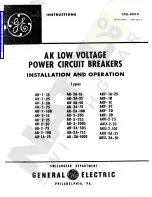
is facing a knife edge pivot on the vertical arm of the bell
crank. The upper end of the link is facing the “Open-Close”
indicator pin. This pin is at the left end of its slot in the mech-
anism side frame with the breaker open and at the right
end with the breaker closed. As the close bar is pushed, the
link as two possible end pivots. If the breaker is open, the
upper end of the link will swing to the right until it touches
the indicating pin. The lower end of the link will then swing
to the right and push the vertical arm of the bell crank to the
right. The horizontal arm of the bell crank moves downward
and presses directly on the spring release latch, allowing the
breaker to close.
If the breaker is already closed and the close bar is pushed,
the upper end of the spring release latch link swings free
to the right because the indicator pin is not there to stop it.
Consequently, no force is applied to the vertical arm of the
bell crank and nothing else happens.
4-5.10 Padlocking Provision
Figure 4-15 shows the essential parts of the padlock
interlock. The breaker is padlocked in the trip-free condition
(Figure 3-3). In this condition, the breaker cannot be closed
nor can it be moved with the levering device.
a. Close Bar (Normal Position)
b. Close Bar (Released Position)
Spring Release Latch
Close Bar Pivot Pin
Bell Crank Pivot Pin
Open-Close Indicator Pin
Bell Crank
Close-Par Cam
Spring Released Latch Link
Spring Release Device
Spring Release Latch Link Pin
Closing Cam Stop Roller
Close Bar
Figure 4-14 Close Interlock Preventing Efforts to Close Already Closed Breaker
Effective July 2010
Instructional Book
IB694C694-03
46
eaton corporation
www.eaton.com
















































